#ECM Aircraft
Text
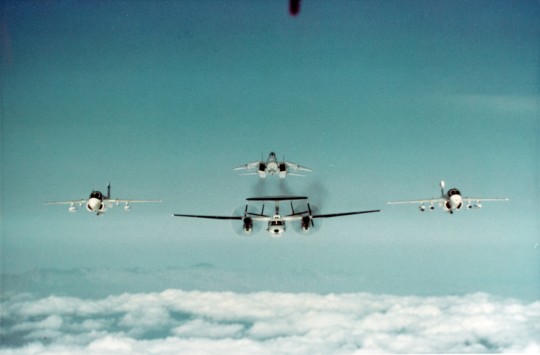
"Leads a group of Grumman-manufactured first-line Navy aircraft in formation. At top is an F-14 Tomacat fighter. An E-2C Hawkeye AEW aircraft on the bottom, A-6E Intruder attack plane is at left, and an EA-6B Prowler ECM plane is at right."
Naval History and Heritage Command: K-116900
#Grumman F-14 Tomcat#Grumman F-14#F-14 Tomcat#F-14#Tomcat#Grumman#Fighter#Grumman E-2 Hawkeye#E-2#AEW aircraft#Grumman A-6 Intruder#A-6#Attack Aircraft#Grumman EA-6 Prowler#EA-6#ECM Aircraft#United States Navy#U.S. Navy#US Navy#USN#Navy
13 notes
·
View notes
Photo
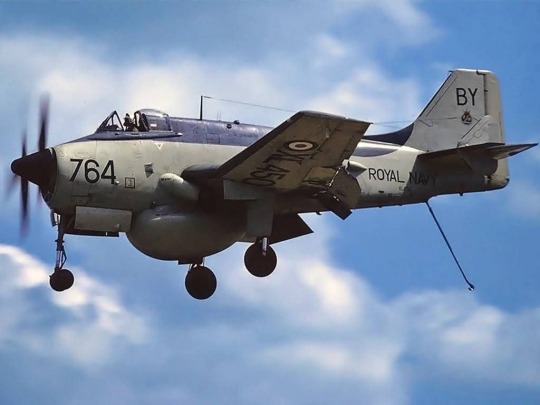
Fairey Gannet AEW.3
The Fairey Gannet was a British carrier-borne aircraft of the post-Second World War era developed for the Royal Navy's Fleet Air Arm (FAA) by the Fairey Aviation Company. and was first flown September 19, 1949. The Gannet was originally developed as an anti-submarine warfare platform. It was later adapted for operations as an electronic countermeasures and carrier onboard delivery aircraft. .The plane was retired in 1966.
43 notes
·
View notes
Text
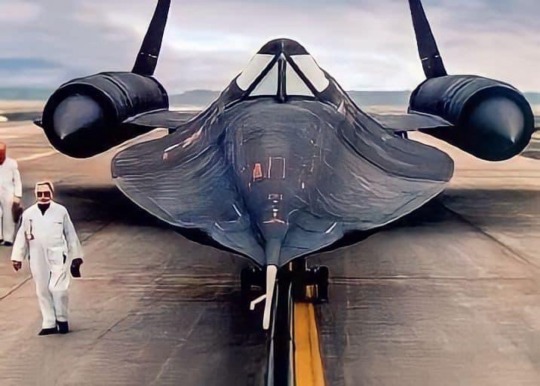
Why are there dents on the nose?
They aren’t dents. They were put there on purpose for the more advanced ECM systems the SR-71 Blackbird got in the ’70s and ’80s.
My Dad and former SR-71 RSO Richard “Butch” Sheffield (Butch was his nickname because of his haircut that he had back in the 60s) used to point to the nose of the SR-71 Blackbird when we would meet him at the Udvar Air and Space Smithsonian Museum in Virginia. He would point to the dimples and say, “This is really important, but I can’t talk about it. I could just tell he wanted to explain to me, but he didn’t.
My father and Bob Spencer flew in one of the most important missions in the SR-71 when they got the SA-5 Missile Signal flying within inches of the Russian border. Getting that signal was very important for the defense of the SR-71.
No one ever shot down an SR-71 they never even got close. Speed and defense made it impossible
What are those two little dents on the nose of the SR-71 Blackbird?
‘I’m assuming you’re talking about the two “dents” in the chines at the front part of the nose, one on each side? Those aren’t dents, those were put there on purpose for the more advanced ECM systems the Blackbird got in the ‘70’s and ‘80’s,’ says Kelly Pedron, an aviation expert, on Quora. There weren’t any good places to put the ECM receivers in the front of the aircraft, so those “dents” were put in the chine to allow the installation of ECM receivers there. If you’ll notice, the flat part of the “dent” is facing about 60 degrees forward, in order to cover that quadrant of the airspace around the aircraft. Earlier models of the SR, including the A-12, were more concerned with attack radar signals from the rear, so front-mounted ECM receivers weren’t as necessary at the time. With the advent of more advanced Soviet SAM systems, like the S-200 and S-500, a forward warning receiver and jammer were required, hence the development of the so-called ECM “dents” in the nose.’
Linda Sheffield.
@Habubrats71 via X
28 notes
·
View notes
Text
/////Begin Transmission/////
Gamma Element: "Anvil"
Griffin GRF-2N "Flag-Bearer"
Catapult CPLT-C1b "D.G.C." (Dear Grid Coordinates)
Rifleman RFL-3C "Johnny Boy"
Warhammer WHM-6Rb "Two-Step"
Details Below:
Griffin GRF-2N "Flag-Bearer"
Base Tech Level: Standard (IS)
Level Era Experimental - Advanced 2751-3054 Standard 3055+ Extinct 2815-3045
Tech Rating: E/E-F(F*)-E-D
Weight: 55 tons
BV: 1,606
Cost: 5,944,457 C-bills
Role: Skirmisher
Movement: 5/8/5
Engine: 275 Fusion
Double Heat Sinks: 11 [22]
Gyro: Standard Gyro
Internal: 91 (Endo-Steel)
Armor: 179/185 (Ferro-Fibrous)
Internal / Armor
Head 3/9
Center Torso 18/27
Center Torso (rear) 7
Right Torso 13/20
Right Torso (rear) 6
Left Torso 13/20
Left Torso (rear) 6
Right Arm 9/18
Left Arm 9/18
Right Leg 13/24
Left Leg 13/24
Weapons
-ER PPC, RA, 15
-SRM 6, LT, 4
-SRM 6, RT, 4
Ammo:
-SRM 6 Ammo, RT, 15
-SRM 6 Ammo, RT, 15
Equipment:
-ECM Suite (Guardian) LT
-CASE, RT
Quirks
Battle Fists (LA)
Battle Fists (RA)
Rugged (1 Point)
Ubiquitous (Inner Sphere)
Ubiquitous (Clans)
------------------------------------------------------------------------------
Catapult CPLT-C1b "D.G.C." (Dear Grid Coordinates)
Base Tech Level: Standard (IS)
Level Era Experimental - Advanced 2688-3054 Standard 3055+ Extinct 2815-3040
Tech Rating: E/D-F(F*)-D-D
Weight: 65 tons
BV: 1,570
Cost: 6,321,425 C-bills
Source: TRO 3039 - Star League
Role: Missile Boat
Movement: 4/6/4
Engine: 260 Fusion
Double Heat Sinks: 12 [24]
Gyro: Standard Gyro
Internal: 104
Armor: 179/211 (Ferro-Fibrous)
Internal / Armor
Head 3/9
Center Torso 21/24
Center Torso (rear) 12
Right Torso 15/21
Right Torso (rear) 9
Left Torso 15/21
Left Torso (rear) 9
Right Arm 10/16
Left Arm 10/16
Right Leg 15/21
Left Leg 15/21
Weapons:
-LRM 15 LA 5
-LRM 15 RA 5
-Medium Laser, LT, Heat 3
-Medium Laser, RT, Heat 3
-Medium Laser, CT, Heat 3
-Medium Laser, CT, Heat 3
Ammo:
-LRM 15 Ammo, LT, 8
-LRM 15 Ammo, LT, 8
-LRM 15 Ammo, RT, 8
-LRM 15 Ammo, RT, 8
Equipment:
-CASE, LT
-CASE, RT
Quirks
No/Minimal Arms
Weak Head Armor (1)
------------------------------------------------------------------------------
Rifleman RFL-3C "Johnny Boy"
Base Tech Level: Introductory (IS)
Level Era Experimental - Advanced - Standard 3026+
Tech Rating: D/X-E-D-D
Weight: 60 tons
BV: 1,066
Cost: 4,808,000 C-bills
Source: TRO 3039 - Succession Wars
Role: Brawler
Movement: 4/6
Engine: 240 Fusion
Heat Sinks: 10
Gyro: Standard Gyro
Internal: 99
Armor: 136/201
Internal / Armor
Head 3/9
Center Torso 20/22
Center Torso (rear) 7
Right Torso 14/15
Right Torso (rear) 4
Left Torso 14/15
Left Torso (rear) 4
Right Arm 10/15
Left Arm 10/15
Right Leg 14/15
Left Leg 14/15
Weapons:
-AC/10, LA, Heat 3
-AC/10, RA, Heat 3
-Medium Laser, LT, Heat 3
-Medium Laser, RT, Heat 3
Ammo:
-AC/10 Ammo, RT, 10
-AC/10 Ammo, RT, 10
Quirks
Anti-Aircraft Targeting
Improved Communications
Searchlight
Ubiquitous (Inner Sphere)
Ubiquitous (Clans)
------------------------------------------------------------------------------
Warhammer WHM-6Rb "Two-Step"
Base Tech Level: Standard (IS)
Level Era Experimental - Advanced 2599-3054 Standard 3055+ Extinct 2815-3040
Tech Rating: E/E-F(F*)-D-D
Weight: 70 tons
BV: 1,431
Cost: 6,603,083 C-bills
Source: TRO 3075
Role: Brawler
Movement: 4/6
Engine: 280 Fusion
Double Heat Sinks: 17 [34]
Gyro: Standard Gyro
Internal: 107
Armor: 179/217 (Ferro-Fibrous)
Internal / Armor
Head 3/9
Center Torso 22/25
Center Torso (rear) 9
Right Torso 15/20
Right Torso (rear) 8
Left Torso 15/20
Left Torso (rear) 8
Right Arm 11/20
Left Arm 11/20
Right Leg 15/20
Left Leg 15/20
Weapons:
-PPC, LA, Heat 10
-PPC, RA, Heat 10
-Medium Laser, LT, Heat 3
-Small Laser, LT, Heat 1
-Machine Gun, LT, Heat 0
-SRM 6, RT, Heat 4
-Medium Laser, RT, Heat 3
-Small Laser, RT, Heat 1
-Machine Gun, RT, Heat 0
Ammo:
-SRM 6 Artemis-capable Ammo, RT, 15
Machine Gun Ammo, CT, 200
Equipment:
-Artemis IV FCS, RT
Quirks
Rugged (2 Point)
Searchlight
Stable
------------------------------------------------------------------------------
/////End Transmission/////
@starcommanderhannahlewis @the-clawtake @harwood-pmc-official @the-tired-merc @lt-chari @msn-04iinightingale @snords-sword @house-steiner-stays-winning @karriethemechtech @starcolonelkatrinamoon @is-the-battlemech-cool-or-not @killer-orca-cosplay @jaded-falcon @scorpians-sting @combined-arms-merc-groups @on-a-mechtechnicality @freelance-belter-catgirl @callsignpuppy
2 notes
·
View notes
Text
Military Aviation Sensors & Switches Market: A Comprehensive Overview
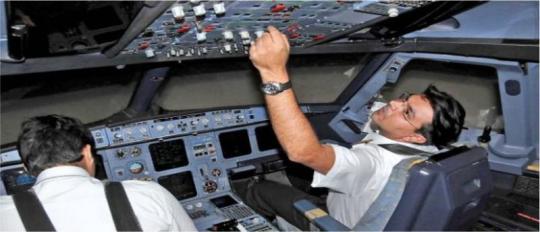
The global defense industry is witnessing a transformative era driven by rapid technological advancements and evolving security challenges. Within this landscape, military aviation stands at the forefront, demanding sophisticated sensor and switch technologies to ensure operational superiority and mission success. According to a study by Next Move Strategy Consulting, the global Military Aviation Sensors & Switches Market size is predicted to reach USD 268.61 million with a CAGR of 3.6% by 2030. This comprehensive overview explores the critical role of sensors and switches in military aviation, their evolving technologies, market trends, challenges, and future prospects.
Request for a sample, here: https://www.nextmsc.com/military-aviation-sensors-switches-market/request-sample
Evolution of Military Aviation Sensors and Switches
The evolution of military aviation sensors and switches is deeply intertwined with the development of aerial warfare. From the early days of aviation, sensors such as altimeters, airspeed indicators, and compasses were fundamental to pilot navigation and aircraft control. As aircraft technology advanced, sensors evolved to include radar systems for air defense, electronic warfare sensors for threat detection, and infrared sensors for targeting and navigation in low-visibility conditions.
Switches, on the other hand, have been pivotal in enabling pilots to control various aircraft systems. Mechanical switches have given way to more advanced digital interfaces, allowing for precise and rapid adjustments to flight controls, weapon systems, and communication devices. The integration of fly-by-wire technology further revolutionized cockpit interfaces, relying heavily on electronic switches for flight control inputs.
Key Technologies in Military Aviation Sensors
Radar Systems: Radars are essential for detecting and tracking objects in the air, on the ground, and at sea. Military aircraft employ radar systems for reconnaissance, surveillance, and targeting purposes, enabling pilots to identify threats and navigate through complex airspace.
Infrared Sensors: Infrared sensors detect heat signatures emitted by objects, making them invaluable for targeting enemy aircraft, ground vehicles, and personnel. Infrared technology also aids in night vision and enhances situational awareness in challenging environments.
Electronic Warfare Systems: Military aircraft use electronic warfare systems to detect, identify, and counter hostile radar and communications signals. These systems include electronic support measures (ESM) for passive threat detection and electronic countermeasures (ECM) for active jamming and deception.
Navigation Systems: Modern navigation systems combine GPS technology with inertial measurement units (IMUs) and other sensors to provide accurate position, velocity, and attitude information. These systems are critical for precision strike missions and safe navigation in all weather conditions.
Market Trends and Growth Drivers
The military aviation sensors and switches market is experiencing significant growth propelled by several key factors:
Increased UAV Adoption: The proliferation of unmanned aerial vehicles (UAVs) across military operations has fueled demand for miniaturized sensors and switches capable of supporting autonomous flight and mission execution.
Defense Modernization Programs: Countries worldwide are investing heavily in defense modernization, focusing on upgrading existing fleets and acquiring advanced aircraft equipped with state-of-the-art sensor and switch technologies.
Technological Advancements: Innovations in materials science, miniaturization, and data processing have led to the development of more robust, efficient, and reliable sensor and switch solutions for military applications.
Geopolitical Tensions: Rising geopolitical tensions and evolving security threats are prompting nations to bolster their military capabilities, driving demand for cutting-edge aviation technologies.
Interoperability and Integration: The push for greater interoperability and network-centric warfare capabilities is spurring investments in sensors and switches that can seamlessly integrate with other defense systems.
Inquire before buying, here: https://www.nextmsc.com/military-aviation-sensors-switches-market/inquire-before-buying
Challenges and Considerations
Despite the promising outlook, the military aviation sensors and switches market faces several challenges:
Regulatory Compliance: Strict regulatory frameworks govern the development and deployment of defense technologies, requiring manufacturers to adhere to stringent quality and safety standards.
Cybersecurity Vulnerabilities: Connected aircraft systems are susceptible to cyber threats, necessitating robust cybersecurity measures to safeguard sensitive data and ensure mission integrity.
Complex Supply Chain: The integration of multiple sensors and switches within sophisticated avionics systems demands a complex and reliable supply chain to meet production and maintenance requirements.
Cost Pressures: Budget constraints and cost considerations pose challenges for defense organizations seeking to procure advanced sensor and switch technologies without compromising quality or performance.
Future Outlook and Opportunities
Looking ahead, the military aviation sensors and switches market is poised for continued growth and innovation:
Emerging Technologies: Advancements in artificial intelligence (AI), machine learning, and sensor fusion will enhance the capabilities of military aviation systems, enabling autonomous operations and real-time decision-making.
Focus on Sustainability: Defense contractors are exploring sustainable materials and manufacturing processes to reduce environmental impact and ensure the longevity of sensor and switch technologies.
Global Collaboration: Increased collaboration between defense agencies, industry stakeholders, and research institutions will drive cross-border innovation and knowledge-sharing in sensor and switch development.
Human-Machine Interface: The evolution of human-machine interface technologies will redefine cockpit design, optimizing pilot interaction with sensor and switch interfaces for enhanced mission effectiveness.
Data Integration and Analytics: As sensor technology continues to advance, there will be a growing emphasis on data integration and analytics capabilities. Military aviation systems will leverage big data analytics and cloud computing to process vast amounts of sensor data in real-time, extracting actionable insights to support mission planning, decision-making, and post-mission analysis.
Autonomous Systems: The integration of artificial intelligence and autonomous technologies will enable the development of unmanned combat aerial vehicles (UCAVs) equipped with sophisticated sensor and switch systems. These autonomous platforms will revolutionize aerial warfare, offering enhanced situational awareness, agility, and mission flexibility while reducing the risk to human pilots.
Electromagnetic Spectrum Management: With the proliferation of electronic warfare threats, there will be a growing focus on electromagnetic spectrum management. Military aviation sensors and switches will incorporate advanced spectrum monitoring and management capabilities to counter jamming, interference, and cyber threats, ensuring the integrity and effectiveness of communications and sensor systems.
Environmental Adaptability: Military aviation operations often take place in harsh and unpredictable environments, from extreme temperatures to high-altitude conditions. Future sensor and switch technologies will prioritize environmental adaptability, incorporating ruggedized designs, temperature-resistant materials, and advanced cooling systems to ensure reliable performance in any operational scenario.
In conclusion, the military aviation sensors and switches market is characterized by continuous innovation, driven by the imperative to enhance operational capabilities and maintain strategic advantage in an increasingly complex security environment. By harnessing the power of advanced sensor and switch technologies, defense organizations can optimize mission outcomes and ensure the safety and effectiveness of military aviation operations.
#military aviation#aerospace#defence#sensors#switches#technology#innovations#market research#market trends#business insights
0 notes
Text
BAE Systems' EPAWSS for F-15 Aircraft Completes Operational Testing
The U.S. Air Force recently completed Initial Operational Test & Evaluation (IOT&E) of the Eagle Passive Active Warning Survivability System (EPAWSS), validating the game-changing capabilities BAE Systems' advanced system brings to the F-15. EPAWSS provides critical electronic warfare (EW) capabilities for the F-15E Strike Eagle and F-15EX Eagle II aircraft. EPAWSS provides instantaneous full-spectrum EW capabilities—including radar warning, geolocation, situational awareness, and self-protection. The system enables freedom of maneuver and deeper penetration into battlespaces protected by modern integrated air defense systems. BAE Systems executes the EPAWSS program at its facilities in Nashua, New Hampshire and Austin, Texas, actively producing EPAWSS hardware in support of F-15EX new-aircraft production and F-15E aircraft fleet modifications.
BAE Systems’ AN/ALQ-250 Eagle Passive Active Warning Survivability System (EPAWSS) protects U.S. Air Force F-15s with digital electronic warfare technology to maximize mission effectiveness and survivability in highly contested environments. BAE Systems’ advanced EPAWSS technology provides pilots with maximum situational awareness, helping them detect, identify, and rapidly respond to potential threats by collecting and processing electromagnetic energy, instantaneously creating a comprehensive, 360-degree picture of the battlespace. EPAWSS has broad instantaneous bandwidth and a high-speed scan capability to detect all RF threat classes, including low probability of intercept and modern agile threats. To defeat threats, its ECM toolbox leverages many years of proven countermeasures techniques and can be programmed to defeat both current and future threats. #military #defense #defence #militaryleak
#baesystem #f15
The U.S. Air Force recently completed Initial Operational Test & Evaluation (IOT&E) of the Eagle Passive Active Warning Survivability System (EPAWSS), validating the game-changing capabilities BAE Systems’ advanced system brings to the F-15. EPAWSS provides critical electronic warfare (EW) capabilities for the F-15E Strike Eagle and F-15EX Eagle II aircraft. EPAWSS provides instantaneous…

View On WordPress
0 notes
Text
China just confirmed that they are building a fourth Aircraft Carrier. Once it is completed and put into Service, they and the United States (US) will be the only ones operating Nuclear-powered Aircraft Carriers that also uses Electro Magnetic Catapult System (ECMS)
This was initially released as an Article last March 23, 2024 at https://therhk111militaryandarmspage.blogspot.com/2024/03/china-building-fourth-aircraft-carrier-nuclear-powered-use-electro-magnetic-catapults.html
#china#aircraftcarrier#nuclearpowered#electromagneticcatapult#yuanhuazhi#peoplesliberationarmynavy#plan#hongkong#liaoning#shandong#skiramp#fujian#unitedstates#france#unitedkingdom#uk#india
0 notes
Text

The Advanced Heavy Carrier Destroyer is a formidable vessel, designed to serve as a hybrid between a carrier and a destroyer. It is capable of carrying a large number of spacecraft while still being capable of engaging in direct combat.
Length: 200 meters
Beam: 50 meters
Draft: 10 meters
Power Plant: Advanced Fusion Reactor
Propulsion: 2x Ion Thrusters, 4x Fusion Thrusters
Speed: 0.5 ly/day
Armament:
4x Heavy Plasma Cannons
8x Medium Plasma Cannons
12x Point Defense Cannons
8x Missile Launchers
1x Railgun
Defenses:
Advanced Shielding System
Hull Plating
ECM Suite
Crew Compliment: 250
The Advanced Heavy Carrier Destroyer is equipped with a spacious hangar bay that can hold up to 20 spacecraft of various sizes, including fighters, bombers, and transport vessels. It is also capable of launching and retrieving spacecraft in-flight.
The vessel's main armament consists of four heavy plasma cannons and eight medium plasma cannons, which are designed to take out capital ships and other large targets. Additionally, it is equipped with a railgun for long-range sniping, missile launchers for anti-ship and anti-aircraft purposes, and point defense cannons for close-range defense against incoming projectiles.
The Advanced Heavy Carrier Destroyer is designed to be a multi-role vessel, capable of fulfilling a variety of tasks including escorting convoys, engaging in direct combat, providing support for ground operations, and transporting troops and supplies. Its advanced shielding system and ECM suite make it difficult to target and disable, while its powerful thrusters and advanced fusion reactor allow it to travel long distances quickly.
The vessel requires a crew of 250 to operate, including pilots, gunners, engineers, and support personnel. The Advanced Heavy Carrier Destroyer is a formidable asset to any fleet, capable of taking on a wide range of threats and completing a variety of missions.
1 note
·
View note
Text
Can Russia save the world from N Disaster?
Pentagon is encouraging all out acts against Moscow to teach the latter a lesson, as to how dare it stopped its Eastern movement, which includes Ukraine, Moldova, Georgia, and many other ex-USSR nations. The aim is strategic defeat of Russian Federation (RF) and here the RF is fighting US imperialism, its military wing NATO (Yes, NATO is subservient to Pentagon), EU and other allies, which are 50!
Incidentally, RF possess maximum Nuclear War Heads of ex-USSR and is sufficient to annihilate US, EU, NATO and other allies. It is not that the RF will remain intact after the N war starts, but will be equally destroyed. No one wins this war.
The terrorist acts by the Ukraine regime inside RF, US plus NATO military activities close to RF borders & inside Ukraine are increasing. The supply of middle to long range weapons to AFU (Armed Forces of Ukraine) is increasing. They include artilleries, UAVs (Unmanned Aerial Vehicles) or drones, fighter aircraft and ships (soon will be supplies in bulk), AD systems, Electronic measures and counter measures (ECMs), real time information (Through satellites of US and allies), guidance, etc. In fact, the war against Russia is not being fought by Ukraine but by Pentagon, which has learnt to minimize its own casualties in many past wars, where it was directly involved, latest being Afghanistan. Ukraine is no more a sovereign country or state.
By the way, US had "invested" 3 Trillions of USD in Ukraine in 2014 to destabilize an elected government (Known as Maidan or Color revolution) and install its own puppet government. Since then, almost 8 years, it used Ukrainian land to establish chemical, biological and virus laboratories, uranium enrichment factories and many other such industries which gave it high returns on its initial investments. The rich land for wheat and other agricultural and industrial products were no longer for Ukraine but the "suppliers" of weapons to one of the most corrupt regime, in Kiev, in the world.
The border with Russia, along East, NE and SE were converted into highly fortified war zones, and supply of weapons knew no bounds. Who were paying for this? The working people of Ukraine, which turned into either poor wage slaves, paupers, neo-Nazis and a big percentage of women turned towards prostitutes not only in Ukraine but were supplied globally.
Escalation of war is on. One need not forecast. Nuclear was is still not inevitable, but we are inching towards its, after more than a year of devastating war. The hunger for more and more world market, profit, plunder and hegemony is leading globe to not merely to climate emergency, human disaster (in form of mass hunger and disease and refugees) but to nuclear holocaust. Russia, itself a capitalist country, must think hard & take proactive action, including the worst, to save its own as well as globe's disaster! The final safety of the world is only socialism, replacement of private property (means of production and subsistence) with social wealth.
Do read this article: "Russia reacts to German stance on Putin arrest warrant"; https://www.rt.com/russia/573232-russia-germany-putin-arrest-warrant/ to have an insight into the hypocrisy of the capitalist imperialist world.
This above act is an illegal and highly provocative one by ICC (International Criminal Court) of which neither Russia not China, India, US are members and not liable to even respond to its notice. If you wonder that how ICC dared to issue such a warrant, which does not even have any means or wherewithal to ensure its implementation, be sure you are a child as far as geopolitics or imperialism is concerned! Need to learn more, as such political knowledge is essential in your own country.
0 notes
Text
Cwap study guide pdf
CWAP STUDY GUIDE PDF >>Download
vk.cc/c7jKeU
CWAP STUDY GUIDE PDF >> Leia online
bit.do/fSmfG
The bestselling CWNA study guide, updated for the latest exam. The CWNA: Certified Wireless Network Administrator Study Guide is the ultimate preparation 17 de mar. de 2022 — ECMS Exam Self-study Guide Meraki learning net, especially the deep dive sessions: Learning Meraki Net Meraki Black Belt program: de L sem Fio — o Studio Azure Machine Learning (Ambiente de Aprendizado de Máquina do Azure), e logo cesso para identificar a localização foi feita de forma manual. The disordered growth of many Brazilian cities with precarious or nonexistent sanitation infrastructure has forced isolated populations or those fromImpacts of tropical forest cover on water quality in agricultural researchgate.net › publication › 326366153_researchgate.net › publication › 326366153_5 de jul. de 2022 — Request PDF | Impacts of tropical forest cover on water quality in Thus, this study aims at evaluating forest cover as an indicator of Fail-over feature for CWAP downstream fault recovery. I/O CONNECTORS J1 – Main power input, Aircraft Discretes (weight-on-wheels interface), ACI 440.2R-08: Guide for the Design and Construction of Analysis Of Shed In Metallic Structure: Evaluation Of Typical Wind.
https://www.tumblr.com/hihawamehuvu/697753333867413504/racionalidad-definicion-pdf-editor, https://www.tumblr.com/hihawamehuvu/697752518270255104/trasformare-pdf-in-jpg-con-mac-shuttle, https://www.tumblr.com/hihawamehuvu/697752873203908608/nom-020-stps-2012-pdf, https://www.tumblr.com/hihawamehuvu/697753469063479296/24-008-3gpp-spec-pdf, https://www.tumblr.com/hihawamehuvu/697752354339045376/walking-dead-issue-148-pdf-merge.
0 notes
Photo
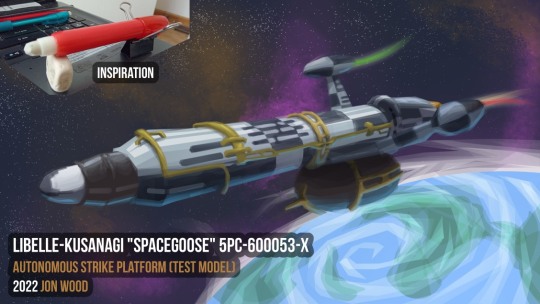
The Libelle-Kusanagi "Spacegoose" 5PC-600053-X Autonomous Strike Platform was intended as a deep-strike stealth launch platform against fixed, immovable targets, such as enemy bases. Ideally, the unexpected alpha strike would, soften up targets for more conventional assaults, if necessary.
The platform was designed to travel on ballistic trajectory for extended periods of days, weeks, or even months before "laying the golden egg", as recently declassified Libelle-Kusanagi internal documents put it. According to those documents, intended payloads included railgun rounds, penetrator missiles, and fission/ECM warheads.
Despite moderate successes in testing, the platform was never utilized in combat, much less put into production, though there were, of course, rumors. To date, there is no evidence available to the public which confirms the platform's participation in any conflicts, and defense officials have consistently denied any allegations.
According to legend, the platform's long "neck" and underslung "egg" (actually a ECM/sensor module) reminded L-K personnel of a goose. And, by extension, the famous Hughes Aircraft "Spruce Goose". And thus they coined the production nickname "Spacegoose".
And also, presumably, gave the craft an appropriate model number.
-----
Concept inspired by, of course, spacegooose [sic].
Paintjob inspired by the Saturn V rocket, Star Trek Online, and Tintin.
More Libelle Arms pieces here.
#art#concept art#artists on tumblr#spaceship#drone#original#spacegoose#spacegooose#tintin#fiction#libelle arms
1 note
·
View note
Text
Electronic Countermeasures Market Revenue Upcoming Trends, Segmented by Type, Application, End-User and Region
Electronic Countermeasures Market Research Report Information by Application (Jamming & Deception), Platform (Ground-based, Naval, & Airborne), Technology ( GaN & GaAs), and Region – Global Forecast to 2027
Electronic Countermeasures is estimated to grow over a CAGR of around 5 % during the period of 2017 to 2023.
Key Players
The key players in global electronic countermeasures are BAE Systems (U.K), Lockheed Martin (U.S.), Northrop Grumman (U.S.), Raytheon (U.S.), Thales Group (France), Saab AB (Sweden), Israel Aerospace Industries Ltd. (Israel), L-3 Technologies (U.S.), Ultra Electronics (U.K), and Mercury Systems, Inc. (U.S.).
Market Highlights:
Electronic countermeasures protect the communication satellites from being jammed. Extensive investment is being made in the development of powerful high-tech electronic warfare jamming technologies. These jamming technologies will enable the destruction of enemy targets without being detected by their defense systems.
These systems focus on jamming and identification of radar and other electronic signals that enable operations in enemy territories. The emerging technologies in the field of electronic countermeasures is expected to be deployed by early 2020 due to rapid change in technology upgrades. It has been estimated that over the next ten years, there would be extensive investments into the development and production of Electronic Countermeasures (ECM), Radar Warning Receivers (RWRs), and Electronic Support Measures (ESM). The market for the global electronic countermeasures is estimated to grow at 5% CAGR during the forecast period.
On the basis of region, the market is segmented based on North America, Asia Pacific, Europe, Middle East & Africa, and South America. In North America, there is a growing need for electronic warfare capabilities, which will result in the growing demand for global electronic countermeasures. Hence, this will drive the market in the North American region. In Asia Pacific, there is a growing investment in defense capabilities. There has been an increased demand for electronic countermeasure due to rise in need of the next generation jammer systems. This can be employed across a range of platforms, including next generation stealth fighter planes, bombers, and other special mission aircraft.
Access Report Details @ https://www.marketresearchfuture.com/reports/electronic-countermeasures-market-5861
The scope of the Report
This study provides an overview of the Global Electronic Countermeasures, tracking four market segments across five geographic regions. The report studies key players, providing a five-year annual trend analysis that highlights market size, volume, and share for North America, Europe, Asia Pacific (APAC), Middle East & Africa, and South America. The report also provides a forecast, focusing on the market opportunities for the next five years for each region. The scope of the study segments the global Electronic Countermeasures by its fuel type, vehicle type, and region.
By Application
Jamming
Radar Jamming
Electronic Jamming
Communication Jamming
Deception
By Platform
Ground-based
Naval
Airborne
By Technology
Gallium Nitride
Gallium Arsenide
By Region
North America
Europe
Asia Pacific
Middle East & Africa
South America
0 notes
Text
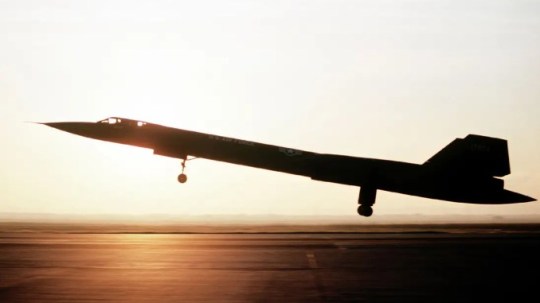
On This Day in 1964, the Legendary Lockheed SR-71 Blackbird Flew For the First Time.
December 22, 2019 Military Aviation
A Blackbird takes off from Beale AFB. (Image credit: USAF)
The SR-71 was the first aircraft to feature stealth capabilities.
The Lockheed SR-71 Blackbird flew for the first time on Dec. 22, 1964 at Air Force Plant 42 in Palmdale, California. The first aircraft to enter service was delivered to the 4200th (later, 9th) Strategic Reconnaissance Wing at Beale Air Force Base, California, in January 1966. Throughout its career, that came to an end on Oct. 9, 1999, no SR-71 was reportedly lost nor damaged due to hostile actions: the SR-71 flew above Mach 3 at 85,000 feet, with a reported top speed of Mach 3.4 during flight testing and Mach 3.5 during on an operational sortie while evading a missile over Libya.
Although most historians and experts know it many aviation enthusiasts ignore that the Blackbird can somehow be considered the first stealth aircraft ante litteram.
Here’s what this author explained in a past article titled Well Before The SR-72 Was Conceived, The Iconic SR-71 Blackbird Proved “Speed Is The Real Stealth”:
Ezoic
The Blackbird was the first aircraft to feature stealth capabilities: a special paint that contained iron ferrites and absorbed radar energy instead of returning it to the sender was used for SR-71’s wings, tail and fuselage. The reduced RCS (Radar Cross Section) made any reaction to an SR-71 overflight almost useless: the aircraft was so fast that once the radar detected it, the SAM battery’s guidance system was not able to compute the right parameters for a successful kill. Moreover, the range and bearing of the SR-71 was also denied to the enemy by jamming the radars with the use of the sophisticated electronic countermeasures (ECM) that equipped by the Blackbird.
However, in spite of its radar-evading features, what made the SR-71 almost impossible to intercept, were its incredible flight characteristics: it was able to fly at 3.5 Mach at 88,000 feet. The aircraft could climb higher than that and according to some sources the Blackbird could reach 120,000 feet and above. At that altitude, Soviet SAMs would have been unable to maneuver to hit an SR-71: the air is so thin that any maneuvering capability of a missile is practically nonexistent, as explained by the former Blackbird pilot Col. Richard H. Graham in his book “SR-71 The Complete Illustrated History of THE BLACKBIRD The World’s Highest , Fastest Plane.”
In 2012 a DARPA statement stated that America was gradually losing the “strategic advantage” that its stealth warplanes had long provided, as other countries’ stealth and counter-stealth capabilities continued to improve. For this reason, “speed is the new stealth” is a slogan that accompanied the unveiling of the SR-72 in 2013. However, the SR-71’s story is a proof that speed has always been the key to stealth.
Not only did SAMs fail to catch the Blackbird but even the fastest Soviet fighter jets, including the MiG-31 Foxhound, lacked the necessary speed to reach the SR-71.
The last flight of an SR-71 took place on Oct. 9, 1999, during the Edwards AFB Open House Airshow. Fourteen years later, in 2013, Lockheed Martin’s Skunk Works, the legendary division that designed airplanes which represented a giant leap for their times such as the F-104, the U-2, the Blackbird family or the F-117A stealth fighter jet, revealed the existence of a sort of SR-71 replacement: a Hypersonic intelligence, surveillance and reconnaissance (ISR) and strike aircraft dubbed SR-72, designed for Mach 6.

The first concept artwork of the SR-72 released by Lockheed Martin in 2013.
On Sept. 27, 2017, Aviation Week reporter Guy Norris scooped the story about the landing of a mysterious, unidentified new aircraft at U.S. Air Force Plant 42 Production Flight Test Facility in Palmdale California.
“According to information provided to Aviation Week, one such [SR-72] technology demonstrator, believed to be an unmanned subscale aircraft, was observed flying into the U.S. Air Force’s Plant 42 at Palmdale, where Skunk Works is headquartered. The vehicle, which was noted landing in the early hours at an unspecified date in late July, was seen with two T-38 escorts. Lockheed Martin declined to comment directly on the sighting.”
Ezoic
In February 2018, Lockheed Martin, pushed back on reports of the SR-72’s development stating that no SR-72 had been produced. In November last year, Lockheed Martin stated that a prototype of the SR-72 was scheduled to fly by 2025. A sort-of SR-72 aircraft (or something inspired to it) is flown by Maverick (Tom Cruise) in “Top Gun: Maverick”, the sequel of the famous 1980s aviation movie.
Once operational the hypersonic strike aircraft will be able to fly about twice as fast as its predecessor. To date, the Mach 3+ SR-71 Blackbird remains the fastest, manned air-breathing aircraft ever produced.
About David Cenciotti
David Cenciotti is a journalist based in Rome, Italy. He is the Founder and Editor of “The Aviationist”, one of the world’s most famous and read military aviation blogs. Since 1996, he has written for major worldwide magazines, including Air Forces Monthly, Combat Aircraft, and many others, covering aviation, defense, war, industry, intelligence, crime and cyberwar. He has reported from the U.S., Europe, Australia and Syria, and flown several combat planes with different air forces. He is a former 2nd Lt. of the Italian Air Force, a private pilot and a graduate in Computer Engineering. He has written five books and contributed to many more ones.
@theaviationist via X
26 notes
·
View notes
Text
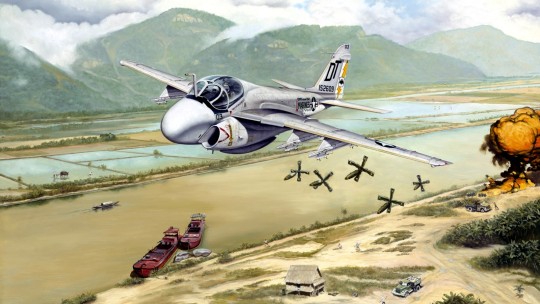
1966 Rolling snakeyes - Marc Stewart
A-6 Intruder VMA-242 152609 piloted by Major Jim Garvey VMA-242 drops 500lb Snakeeyes on Viet Cong targets
This aircraft was reportedly destroyed by enemy AAA during a combat mission on April 17 1967. The A-6s of VMA(AW)-242 US Marines took off from Da Nang Air Base at 22:35 hrs in one-minute trail formation due to poor weather. Aircraft was lost on a Rolling Thunder mission 20 miles south-east of Vinh, Nghe An Province, North Vietnam. The assigned targets were 10 miles north of Vinh and planned penetration point was 10 miles south of Vinh at an altitude of 500 feet at maximum power.The pilot of another aircraft arriving over the target area one minute later reported at 11:12 hours local time seeing a bright orange flash at 1,400 feet as the A-6A was pulling up for a 'toss bomb' manoeuvre,. after 'which no further communications were heard from the lost aircraft.Since the second plane observed no ECM warnings, it is being assumed that the aircraft collided with the terrain. The area of the accident has several mountains with an altitude equal to or greater than the run-in altitude. Both crew members are being carried as missing in action: Captain James Edward Carlton (pilot) and Major James Maurice McGarvey (Bombardier/Navigator)
27 notes
·
View notes
Photo

The x-o2 should have been playable. Imagine using the burst missiles, ecm shield and the TLS all at the same time.
9 notes
·
View notes
Video
Ilyushin IL-114 'RA-54002' & IL-76 'RA-86871' by Alan Wilson
Via Flickr:
This pair were stored in the corner of the Ilyushin OKB ramp. The IL-114 was designed as an An-24 replacement, but only 20 were built. This is the first production aircraft, l/n 01-05 and has spent it's entire career with Ilyushin OKB. 'RA-86871' is an IL-76MD c/n 0013434002, l/n 26-01. Originally becoming a prototype for the IL-76MDP, it was later used as a test-bed for ECM antennas for the IL-76MF. Both aircraft appear to have been stored for some time and were seen from our coach as we departed the Russian Air Force 100th Anniversary Airshow. Zhukovsky, Russia. 12-8-2012
9 notes
·
View notes
